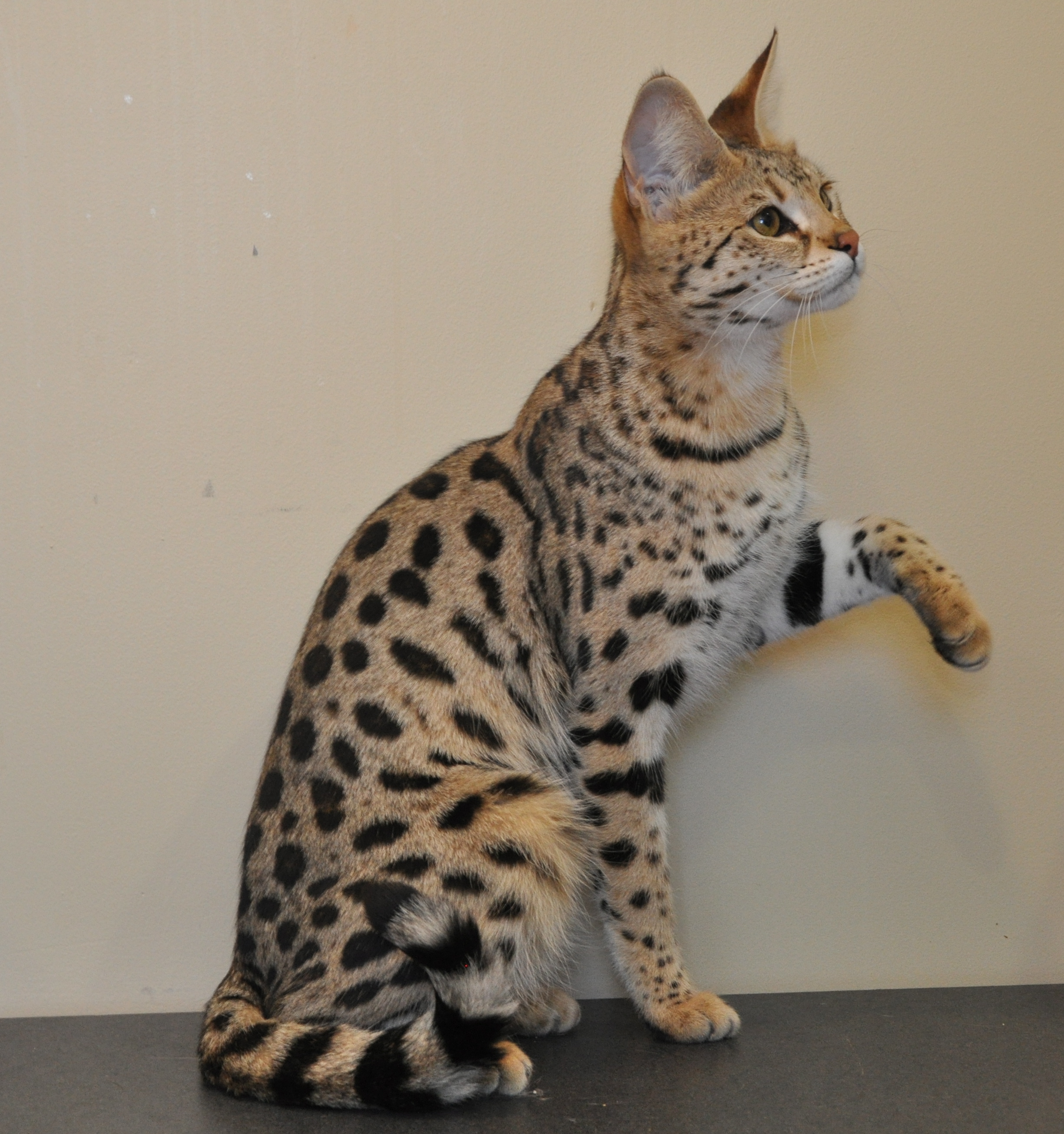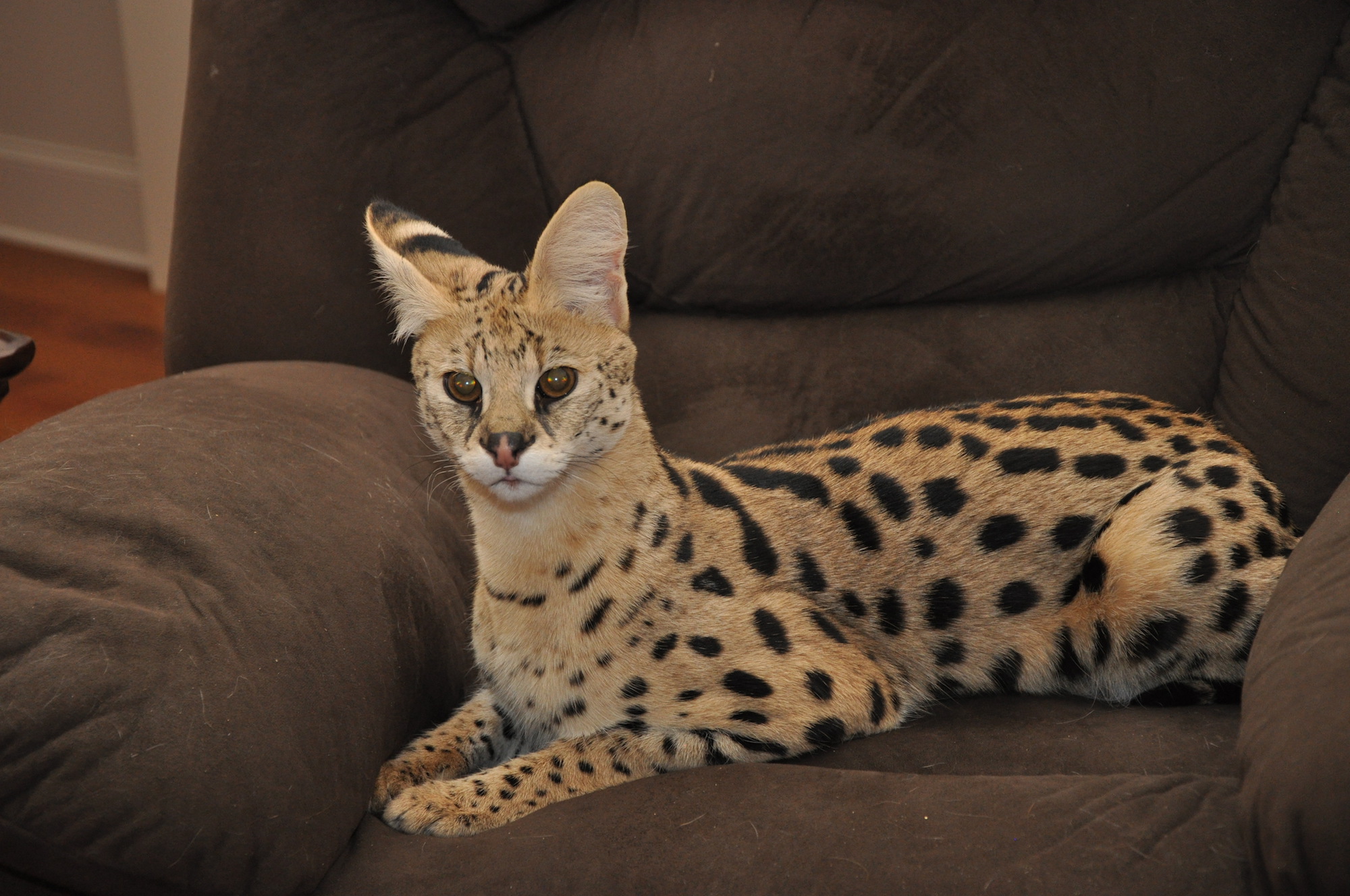About Savannahs
Learn more about this fascinating breed!
About
Savannahs
The Savannahs’ tall and slim build gives them the appearance of greater size than their actual weight. Size is very dependent on generation and sex, with F1 hybrid male cats usually being the largest.


More Information
How do they get their "F Ratings"?
F1 Savannahs can be as high as 75% Serval. 75% F1’s (technically a Back-Cross BC1) are normally the offspring of a 50% F1 (true F1) female bred back to a Serval. There have been cases of 87.5% F1 (technically BC2)Savannah cats but fertility is questionable at those percent Serval levels. More common than a 75% F1 is a 62.5% F1 which is the product of an “F2A” (25% Serval, female) bred back to a Serval. The F2 generation, which has a Serval grandparent and is the offspring of the F1 generation female, ranges from 25% to 37.5% Serval. The F3 generation has a Serval great grandparent, and is 12.5% Serval.
A Savannah/Savannah cross may also be referred to by breeders as SVxSV (SV is the TICA code for the Savannah breed), in addition to the filial number. Savannah generation filial numbers also have a letter designator that refers to the generation of SV to SV breeding. The letters are A, B, C and SBT. A designation of A means that one parent is a Savannah and the other is an outcross. B is used for both parents are Savannahs with one of then being an “A”. “C” is both parents are Savannahs and one of them is a “B”. Therefore A x (any SV) = B; B x (B,C,SBT) = C; C x (C, SBT) = SBT, SBT x SBT = SBT. F1 generations Savannahs are always A since the father is a non-domestic outcross (the Serval father). F2 generation can be A or B. F3 generation can be A, B or C. F4 Generation is the first generation that can be a SBT. SBT stands for “stud book tradition” and is considered a “purebred” cat.
Being Hybrids, Savannahs typically exhibit some characteristics of hybrid inviability. Because the male Savannah is the heterozygous sex, they are most commonly affected, in accordance with Haldane’s rule. Male Savannahs are typically larger in size and sterile until the F5 generation or so, although the females are fertile from the F1 generation. Currently (2011) breeders are starting to notice a resurgence in sterility in males at the F5 and F6 generation. Presumably this is due to the higher serval percentage in C and SBT cats. The problem may also be compounded by the secondary non-domestic genes coming from the Asian Leopard Cat in the Bengal outcrosses that were used heavily in the foundation of the breed.
Savannah Cat Myths
Myth #1 – All Savannahs are HUGE!!!
Savannah size can vary from close to the very tall Serval ancestor to the more average domestic cat height. The most consistently large generation is of course the F1 generation as it has the Serval parent contributing half their genetic make up. Interestingly though, some of the tallest Savannahs around are F2 generation, but the range of sizes in the F2 generation is more variable. There are some pretty nice-sized F3s but further on most Savannahs of lower generations (and that is the MAJORITY of the Savannah population) are simply taller and longer than the average domestic.
Of course most breeders have produced a nice big Savannah and if we all wished to do so we could take a picture of that tall cat walking with a petite toddler and photograph it so that the cat was walking in front hence exaggerating this cat’s size…but most Savannah breeders feel it is more ethical not to create such a false image of our breed. This unfair impression of the breed’s size leads to buyer disappointment, and sometimes I fear the expectation of size can lead to the new owner not valuing the other great traits of their Savannah (exotic looks and great personality) because they are upset because it is not the Labrador-sized kitty they were dreaming of.
Myth #2 – Savannahs are “wild and dangerous”!!!
The African Serval is known to be one of the most “domesticatable” of the exotic cats, the reason it is more commonly kept as a housepet than most other wild cats. Savannah Rescue does NOT recommend this at all, it is still a wild cat and as such unpredictable and not easy to live with. But the fact remains that it is more gregarious and interactive with humans than most other wild cats. And most importantly it doesn’t view the human as prey. So by crossing this exotic cat with a domestic cat we do not get an F1 Savannah that is difficult to handle, antisocial or dangerous. We get a very high energy, interactive, housepet that although more suited to some pet households than others, makes a wonderful loving pet for many.
It is Savannah Rescue’s opinion that F2 and onwards are the better pets, F1s are more intense and more determined to have their own way than most cats and therefore take a more experienced and prepared household. Much like not all people should have certain dog breeds, I would counsel one about deciding on a Beagle as pet for example. I love my beagle, but he’s a lot of hard work!
Myth #3 – Asheras are Not Savannahs
It seems that Asheras were indeed Savannahs marketed heavily for an exceedingly inflated pricetag. Buyer beware, do your research!
Myth #4 – All Savannahs are Super-Expensive
Yes, the early generations of Savannahs are expensive. They are difficult to produce and a lot of work goes into them. The later generations, the F4s and F5s are a different situation. Being mainly domestic (an F5A is theoretically 97% domestic heritage for example) they are just as easy to produce and raise as a domestic cat. Therefore you just might see lower generation Savannahs offered for the same prices as many domestic cat breeds…and possibly by the same kinds of lower-quality breeders for cut-rate pricing. If a Savannah is offered for very very little money, there just might be a reason for it! That’s not to say that if a cat is priced very high it must be of good quality of course. There’s extremes both ways, and people that advertise “supreme” branding that are outrageously priced are as much to be avoided. Always do your research and ask questions about why a kitten is priced high or low.
Myth #5 – Savannahs Need to Have a Raw Meat Diet
Sure there are Savannah breeders that prefer to feed their cats a raw diet, but there are also Birman, Ocicat and Tonkinese cat breeders that do the same and swear their cats are healthier for this diet. It’s easy to assume that these things must be true due to the “wild heritage” of the Savannah.
Myth #6 – Savannahs Cannot Be Around Small Children or Pets
Most Savannahs live in houses not only with humans but with other pets, in particular other cats and dogs. They do very well with dogs, maybe as they tend to be on the more confident outgoing end of cat personalities. Like most cats though, they think fish tanks and mice cages are toys, and would love to get into their toy and play more directly. Therefore we recommend that all those kinds of pets are kept in very secure accommodations, and possibly with a door between them and the kitty when not supervised.
Myth #7 Savannahs are Super-Predators
Myth #8 – ALL Savannahs Love Water
It does however seem that a lot of Savannahs are comfortable with water in a way that most domestic cats are not. They may still not be impressed when you dunk them in a bath, but they may join you in the shower to bat at the spray and they may get under the tap in the bathroom making it impossible to wash your face easily at night. How much of this is due to Serval and how much is due to them being a highly interactive and enthusiastic personality breed, I don’t know. In any case, when you get your Savannah kitten, don’t assume it will enjoy being thrown into a full bathtub. Run the tap and see how interested your kitten is… make the water lukewarm in temperature and inviting. Run a bath with a couple of inches and throw in some ice cubes or bath toys. It can be very amusing, but only if your particular kitty enjoys water sports!
